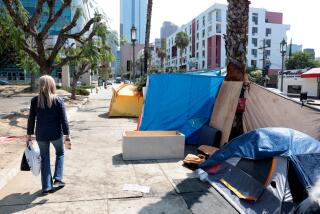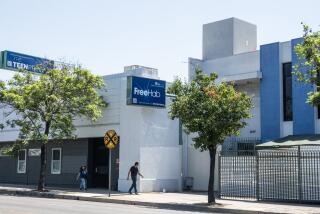Out of the Abyss
In suicide, Lois Smith saw symmetry. Her mother died on Jan. 30, 1979, and her uncle’s death followed exactly one year later. So on Jan. 30, 1993, the mother of three, grandmother of two, lay in bed strung out on crack cocaine, broke and darkly contemplative.
“I might as well make it a trio,” she thought, a tragic three of a kind.
Lois had gambled professionally for 20 years, sold drugs and had been a heavy user the previous two years. She believed that cards unveiled themselves in cryptic patterns. From an early age she was fascinated by numbers and so she studied the cards carefully, searching for mathematical rhythms, a tilt of balance from chance to skill.
“You can’t just go into a gambling house and gamble,” she says. “You have to study it and learn it. It’s like an art.”
In such a way, she studied death, and ultimately it was neither a grand commitment to life, nor a pronouncement to endure that brought forth her decision to live. Time merely ran out. Jan. 30 had come and gone. The numbers changed. The symmetry was gone.
Lois took inventory, and through the chaos of desperate thoughts saw that she had one hand left to play. She held three aces--her three children. This hand led her to recovery and sustained her through 18 months of treatment.
“They kept me going,” she says. “They still loved me despite what I had done.”
Experts say the role of children in their parents’ recoveries is powerful. As Rock Bottom becomes more and more crowded, it is children who increasingly lead the way from darkness through treatment programs focusing on relationships, particularly that between parent and child.
“Our emphasis in this program is on building relationships; relationships with themselves, their self-image, their relationship with God, relationships with people who love them and support them,” says Annetta Turner, director of the Anne Douglas Center, the women’s portion of the Los Angeles Mission, where Lois enrolled herself in the City Light Rehabilitation Program.
Of 15 women currently in City Light, 10 are parents, and nine say their children were instrumental in their decisions to get treatment.
A 1995 clinical study conducted at PAR Village, a residential treatment program in St. Petersburg, Fla., which allows young children to live with their mothers during recovery, determined that “permitting cocaine-abusing women to live with their children in a therapeutic community appears to prolong the retention of these women in treatment. Such a provision could strengthen important mother-child bonds while improving post-treatment outcomes, given that the length of stay in substance abuse treatment has been found to be the most consistent predictor of positive outcome.”
Monessa Overby, clinical manager of family, children and outpatient treatment at the Betty Ford Center, says we often listen to our children in a way that we listen to no one else.
“I have seen children make one or two statements that get through to an alcoholic or addict where five, six, seven other adults in the room haven’t gotten through,” she says. “But I don’t ever want to put the burden on the child to take the responsibility for intervening.”
Such a statement led Lois to seek help. “You don’t even look like our mother anymore,” her oldest son, Aaron, told her the week before she contemplated suicide.
She knew he was right. She had lost weight, her face was weary and drawn, her eyes were void of hope. Over and over, she heard Aaron’s words. They followed her as Jan. 30, 1993, passed.
And they chased her to the front door of City Light.
*
Seanarae Smith, 29, was a senior at Cal State Los Angeles, on the verge of becoming the family’s first college graduate, when her mother went into treatment.
In many ways, she and Aaron, 31, had taken charge of the family since 1991, when Lois began using drugs heavily. They were the ones who would bail her out of jail, make sure the rent was paid, plead with her to get help.
In 1992, Aaron took in younger brother Derrick, then 16, when it became obvious that Lois no longer could provide for him.
“Once she got off into drugs, it was like Aaron and I became parents instead of being children,” Seanarae says. “We weren’t her kids anymore. It was like she was our kid. . . . At times, she felt we were disrespecting her. She wasn’t being responsible, and somebody had to be, so it had to be us.”
Women in the City Light program are not allowed visitors for the first 30 days of treatment. Lois was nervous the first time her children came to see her.
“I thought they would be ashamed of me, but they weren’t,” she says. “They showed how much they cared for me and loved me. They told me they were glad I was there, and that made me feel good.”
Lois hugged all three of them at the end of their two-hour visit. She had rarely done that. Later in the 18-month program, she apologized to them for past mistakes.
“All my life . . . I would never apologize,” she says. “I’d just say, ‘So what?’ But I had to take a good, hard look at myself in parenting class. I had never made a habit of telling them I loved them. I bought them stuff, and I loved them, but I never told them. I didn’t hug them.”
In June 1993, Seanarae graduated with a degree in theater arts. Lois had no money to buy her a gift. “It was such a great accomplishment,” she says. “She worked so hard to graduate from college. A lot of parents will buy their children cars or something big and fancy, but I didn’t have anything. . . . I felt like I hadn’t done anything with my life, and I couldn’t even buy my daughter a present.”
Lois decided to write about those feelings. A volunteer typed it, dressed it up and framed it.
“Seanarae, my one and only daughter: I love you very much. I cannot express in words the way I feel about my baby right now. Yes, to me you will always be Mommy’s little girl, so caring, joyous, loving and so full of life. You, Aaron, Derrick and God are my life. I love all of you. . . .”
It was, says Seanarae, the best gift her mom could have given her.
*
Each week, her children visited, approaching Lois’ recovery as a family. Lois says she is fortunate her children were old enough to fend for themselves. Young mothers who have no one to care for their children oftentimes do not seek treatment, experts say, until the children are taken from them.
The City Light program is now trying to raise $2.2 million to purchase residential property so that low-income women in crisis who have children can keep their families together, making treatment more available and effective.
There are more than two dozen programs in Los Angeles County that allow children to stay with mothers during drug and alcohol treatment, but most are small because of the expense of staffing and providing housing for families.
With the help of her children, Lois, 49, has been clean for more than three years. She is president of the City Light alumni group and lives with Seanarae and Derrick, now a student at Harbor Community College, where he plays football and studies computer science.
*
Lois’ fascination with numbers led to a school, and then a job preparing tax returns for H&R; Block. She now is office manager of an L.A. law firm, doing the bookkeeping, billing and payroll. She also sells Avon and works one day a week at the mission as an advisor.
She lives in the same neighborhood where she once did drugs, where she would change into ragged clothes then go out panhandling. It’s not far from a bridge she thought about on Jan. 30, 1993. It is built a good distance above a concrete ravine.
She rarely thinks about it anymore.


